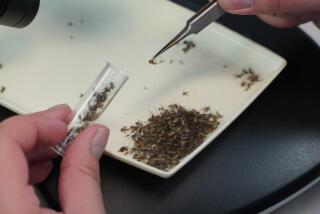Spring Swarms: Open Season on Termites
- Share via
Orange County is known for its mild climate, but the mix of heavy rains and salty air creates a breeding ground for termites. Their destructiveness costs homeowners an average of $2,500 to treat an entire house. How to spot termites and steps to get rid of them:
Western Subterranean Termites Travel in mud tunnels that are easy to spot, eat wood, then return to nests in soil * One mature colony averages up to 1 million termites * Queen lays up to 10,000 eggs each year * One colony can eat 2 1/2 feet of wood each year
Western Drywood Termites Live above ground, deep inside wood; can do plenty of damage before you discover their colonies. Also nest in dead tree limbs, stumps and fence posts * One mature colony averages 2,600 termites * Queen lays up to 1,000 eggs each year * Single colony can spread into several rooms in a few weeks
Tell-Tale Signs 1) Mud tunnels 2) Decay of internal or external wooden beams 3) Hollow or blistered attic eaves 4) Piles of sand-like substance or discarded wings; look for them on window sills, near pipes coming from the foundation or around cracks or holes in floors and walls
Where Termites Enter Wood contacting the ground Joists, subfloor Cracks in foundation walls Soil next to foundation wall Termites can follow chemneys to upper areas
The Fumigation Process What You Should Do * Remove plants, pets (including fish from tanks), open foods and medicines from home. * As an extra precaution, remove wet suits, disposable diapers and waterproof bed liners. * Leave cold or frozen foods in fridge or freezer only if wrapped in four-millimeter thick plastic. * Check closets and cabinets for pets or perishables; leave closets and drawers open. * Expect to be displaced at least two nights and three days. * Upon returning home, there’s no need to wipe off dishes or change bedding, because gases leave no residual coating. What Exterminator Does Must provide homeowner with a written consent form to use fumigants in home. These forms describe fumigation process, chemicals and hazards involved. 1) Thoroughly checks house for anything that shouldn’t have been left behind. 2) Shuts windows; installs secondary lock on front door. 3) Temporarily removes exterior awnings, wooden fencing or porches, if necessary, to provide secure tarping. 4) Drapes tarpaulin over structure and clips into place. 5) Pumps a lethal gas (methyl bromide or Vikane) into home. Afterward, tear gas is often used as a malodorous warning agent. 6) Posts “keep out” signs around the house; tarpaulin is left in place for one to three days. 7) Removes tarp; opens windows and sets up fans inside home to pull in fresh air. 8) Repairs awnings, fence or porch, if needed. How Fumigants Work 1) Vikane and methyl bromide remove oxygen from the air. 2) Penetrate walls, sinking into pores of wood. 3) Termites and other insects will die, but spiders, which breathe only once every 30 to 40 hours, may not be harmed by the gas. Ants and other insects can reinfest the home through the same entries they used prior to fumigation. Spot treating with an insecticide spray may be necessary. Alternative Methods These methods are best for termites contained only in small areas. * Freezing: Liquid nitrogen lowers temperature of wood; freezes termites. * Electrogun: A gun fires electrical currents inside a hole where termites empty trash from their nest. The current runs down the tunnel where termites have chewed through wood, killing any insects in its way. * Heat: Specific room or wall is heated until termites and nesting area are killed. * Microwave system: Microwaves are focused on a wall or area, cooking termites inside out. Avoiding Re-Infestation * Insulate home to reduce moisture on pipes and crawl spaces. * Properly ventilate the attic. * Clear away firewood, loose stumps or building materials from around house. * Remove trellises or rotting window shutters from outside walls. Sources: California Structural Pest Control Board, Orkin Pest Control, DowElanco; Researched by APRIL JACKSON / Los Angeles Times






